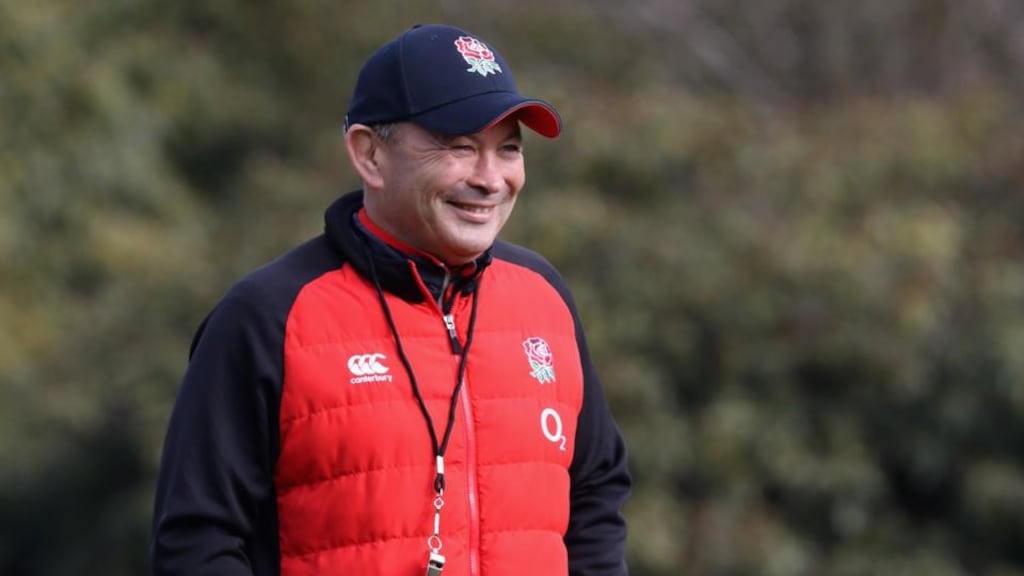Eddie Jones’s training sessions are likely to come under scrutiny after a report published on Monday revealed that the severity of injuries sustained during England camps in his first full season in charge drastically rose.
The Professional Rugby Injury Surveillance Project, jointly commissioned by the Rugby Football Union and Premiership Rugby, reported injury data for the 2016-17 season and showed that the “burden of injuries” – which takes into account both their frequency and their severity – more than doubled at England training compared to the previous campaign.
Jones conducts notoriously gruelling training sessions and has stated previously that when his players join England from their clubs they are not at the levels of conditioning required for Test rugby. He insisted throughout the Six Nations that his players were not showing signs of fatigue – stating he had GPS data to prove as much – but the findings are likely to raise eyebrows among the Premiership clubs, who are often blamed for not giving their international players adequate rest.
Injuries such as that sustained by Sam Jones – the flanker broke his right leg in a judo session at a national training camp in Brighton in October 2016 – will have skewed the data somewhat but the RFU’s medical services director, Simon Kemp, did reveal, across the board, training accounts for 36 per cent of all injuries in what is an alarming study into the injury toll in the English game. “England review this data in the same way that clubs do,” Kemp said. “You’ve got to be very cautious with the England data because it’s just a single club. But England get this data and it informs how they plan training.”
Meanwhile, World Rugby has been urged to consider reducing the legal height for a tackle after there was an increase in incidents of concussion for a seventh consecutive season with Kemp suggesting that the directive from the global governing body to take a zero-tolerance approach to contact with the head needed to be better enforced. He said: “We would like World Rugby to give consideration to thinking about reducing the legal height for the tackle. There’s very little margin for error with the permitted height of the tackle at the line of the shoulders. If you design a law to make the game more free-flowing and open, you need to monitor it carefully to make sure it doesn’t have an adverse consequence on injury risk.”
The RFU has defended its £50m investment into community artificial pitches after the report also revealed an injury spike on synthetic surfaces among elite players. The RFU announced its four-year commitment to develop 100 pitches nationwide in 2015 and unveiled the first three last January but Monday’s findings have prompted further analysis of artificial pitches to be commissioned as part of the report’s eight-point plan.
Saracens, Worcester and Newcastle all have artificial pitches and the report showed for the first time that the number of injuries, and their severity, was significantly higher on artificial turf than on natural grass. “I think you’ve got to separate the [elite game and community game]. These things are totally different games,” the RFU’s director of professional rugby, Nigel Melville, said. “In the professional game, we’re doing one piece of analysis and in the community game, we’re doing another in similar guises to this.”
For the 2016-17 Premiership season, there was an average of 3.8 injuries per match. The report also showed that 47% of all match injuries are associated with the tackle, with an almost equal split between tackler and the ball carrier. Concussion accounted for 43% of injuries to the tackler and 19% to the ball carrier. With such a high proportion of injuries suffered during training however, it raises questions over how well club and country are managing players’ workloads.
“Looking at the data this year, we felt like we needed to take some proactive action,” said Premiership’s rugby director, Phil Winstanley. “We know that the injury risk changes if you play less than 15 and more than 35 matches. The vast, vast majority of our players fall within those parameters which would suggest that the load is not impacting on the injury risk.”
(Guardian service)












